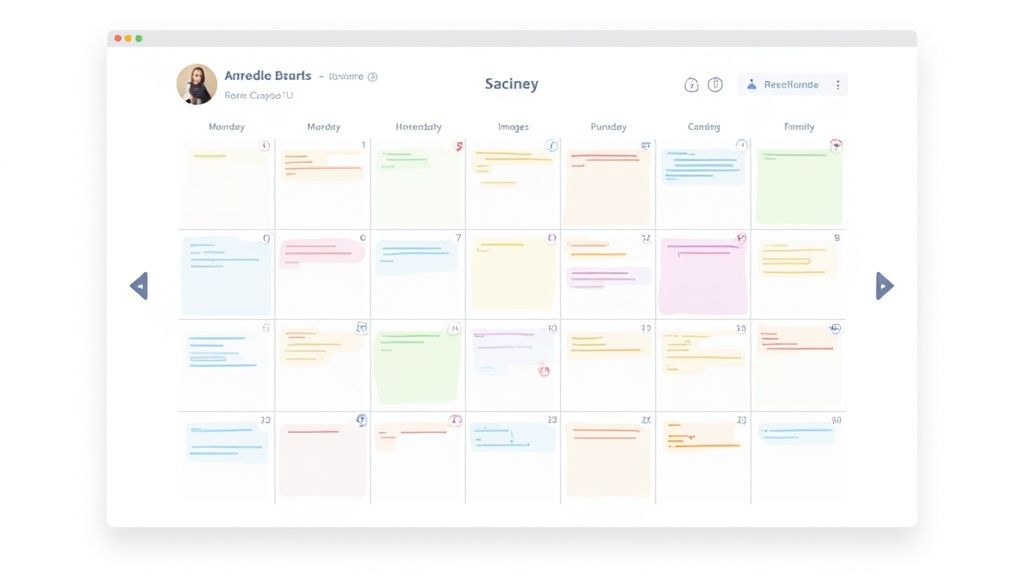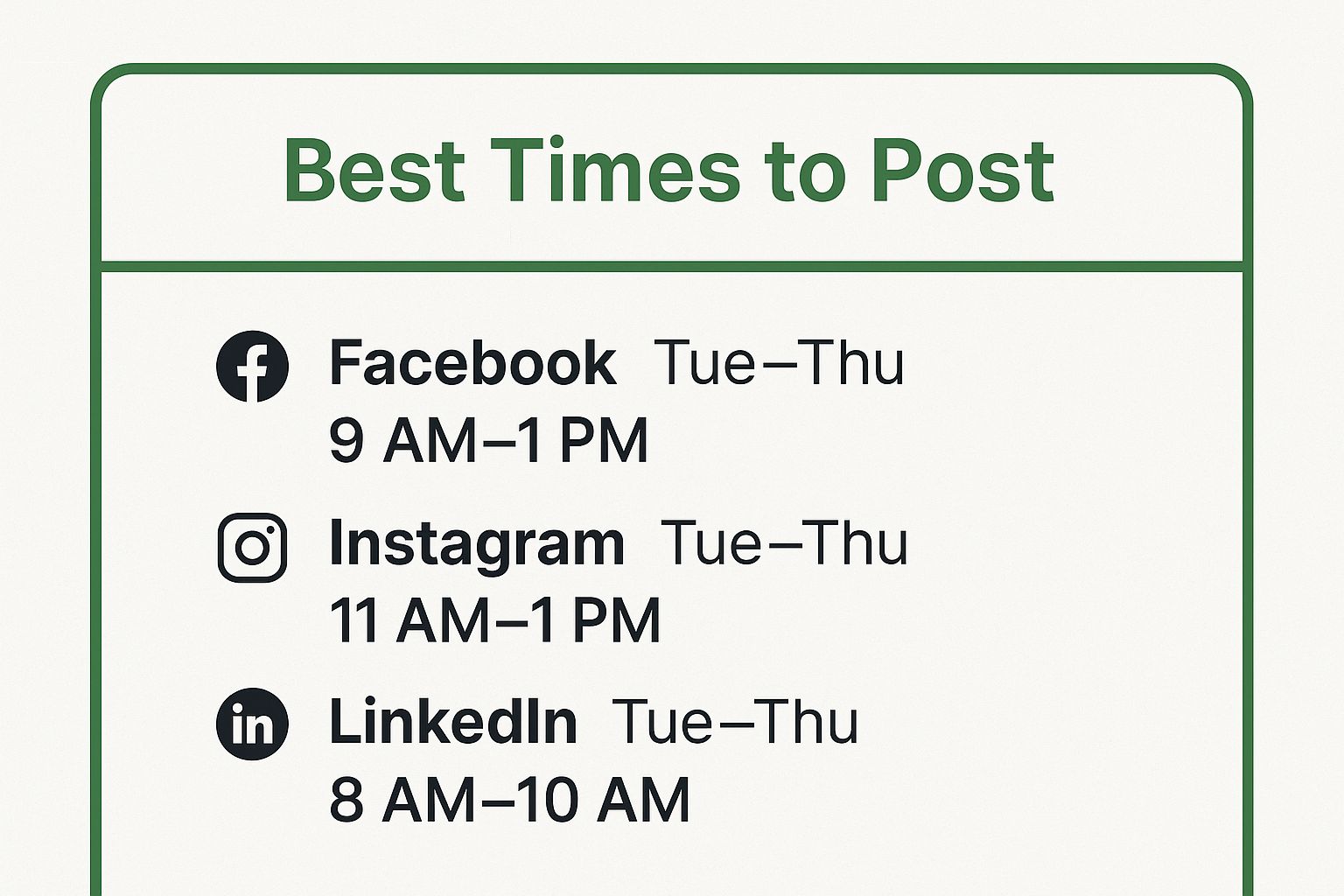7 Essential Social Media Management Tips for 2025
A strong social media presence is essential, but managing it effectively can feel like a constant battle against the clock. Between creating content, scheduling posts, engaging with your audience, and analyzing performance, it’s easy to feel overwhelmed. The secret to success isn't just about working harder; it's about working smarter with a clear, strategic approach. That’s precisely why we’ve created this guide.
This article cuts through the noise to deliver a curated list of high-impact social media management tips. We move beyond generic advice to provide actionable strategies that save you time and drive meaningful engagement. You will learn how to streamline your entire workflow, from planning a content calendar to leveraging data for better decisions. We'll also highlight how tools like Publora can centralize your efforts, integrating everything from scheduling and analytics to AI-powered content creation, so you can focus on building your brand without burnout.
Whether you're a solo creator, a small business owner, or part of a marketing agency, these seven tips are designed to transform your social media efforts from a daily chore into a powerful, efficient growth engine. Let's get started.
1. Develop a Consistent Content Calendar
One of the most effective social media management tips for achieving long-term success is to stop posting on the fly and start planning with a content calendar. This is a strategic scheduling system that outlines precisely what you will post, where you will post it, and when. It transforms your social media from a reactive chore into a proactive strategy, ensuring a consistent brand voice and a steady stream of content for your audience.

A well-structured calendar allows you to align every post with your larger business goals, from driving website traffic to promoting a new product. Brands like Starbucks expertly use calendars to plan seasonal campaigns, such as their famous holiday cup promotions, months in advance. This foresight prevents last-minute scrambling and maintains a high standard of quality.
How to Build an Effective Content Calendar
Getting started is simpler than it sounds. The key is to create a framework that works for you and your team.
- Establish Monthly Themes: Assign a broad theme for each month, such as "Customer Success Stories" or "Behind the Scenes," to guide your content creation.
- Apply the 80/20 Rule: Dedicate 80% of your content to providing value, such as tips, entertainment, or educational posts. Use the remaining 20% for promotional material.
- Color-Code Content Pillars: Use different colors to categorize your posts by type (e.g., video, blog post, user-generated content, promotion). This helps you visually confirm you have a balanced content mix at a glance.
- Stay Flexible: Leave a few empty slots in your calendar each week to accommodate trending topics, breaking news, or spontaneous engagement opportunities.
To keep your schedule full of high-quality visuals and copy, it’s helpful to have the right creative resources. To efficiently populate your content calendar with diverse and engaging material, explore top social media content creation tools.
By planning ahead, you not only save time but also create a more cohesive and impactful social media presence. For a step-by-step walkthrough, see our social media content calendar essential setup guide.
2. Engage Authentically with Your Audience
One of the most powerful social media management tips is to move beyond automated, one-size-fits-all communication and start engaging authentically with your audience. This means fostering genuine, two-way conversations that build real relationships. It involves actively listening to your followers, responding with personalized messages, and showing the human side of your brand to create lasting trust and loyalty.

Authentic engagement transforms your social media presence from a simple broadcast channel into a thriving community hub. Brands like Wendy's have mastered this with their witty and highly personalized Twitter responses, making them a cultural phenomenon. Similarly, Glossier built its empire by listening to its community and co-creating products based on real feedback, demonstrating the immense value of genuine connection. This approach makes your followers feel seen, heard, and valued.
How to Foster Authentic Engagement
Building authentic relationships requires a commitment to being present and personal. The goal is to make every interaction feel meaningful.
- Respond Promptly and Personally: Aim to reply to comments and messages within a few hours during business hours. Use the person's name to make the conversation feel individual and less robotic.
- Ask Follow-Up Questions: When someone leaves a comment, don't just "like" it. Ask a follow-up question to encourage a deeper conversation and show you are genuinely interested in their thoughts.
- Acknowledge All Feedback: Thank users for positive comments and address negative feedback professionally and transparently. Acknowledging criticism with respect can turn a negative experience into a demonstration of excellent customer care.
- Share Behind-the-Scenes Content: Pull back the curtain and show the people and processes that make your brand unique. This humanizes your business and gives your audience a reason to feel connected.
To truly connect with a diverse audience and ensure your video content is accessible to all, consider leveraging tools that help you easily learn how to add subtitles to your social media videos. This small step shows you care about every follower's experience.
3. Leverage Data Analytics for Strategic Decisions
Posting great content is only half the battle; understanding its impact is what separates good social media management from great. Leveraging data analytics means moving beyond guesswork and using concrete numbers to inform your strategy. This involves collecting, analyzing, and interpreting data from social platforms to understand audience behavior, content performance, and campaign effectiveness, enabling you to make smart, data-driven decisions.

This data-driven approach allows you to optimize your efforts for maximum ROI. For example, Netflix meticulously analyzes content engagement metrics like watch time and shares to decide which shows to renew and what new content to produce. Similarly, Spotify’s famous "Wrapped" campaign is a masterclass in using user data to create highly shareable, personalized content that also provides the company with immense brand engagement insights.
How to Use Analytics for Better Decisions
Making analytics a core part of your social media management tips and routine is crucial. It helps you identify what’s working, what isn’t, and where to allocate your resources.
- Focus on Key Metrics: Don't get overwhelmed by vanity metrics like total followers. Instead, focus on 3-5 key metrics tied to your goals, such as engagement rate, click-through rate (CTR), and conversion rate.
- Set Up Automated Reporting: Use the native analytics tools on platforms like Instagram and Facebook, or a dedicated tool like Publora, to set up automated weekly or monthly reports. This keeps you consistently informed without manual effort.
- Track Competitor Benchmarks: Monitor your competitors’ public metrics to see how your performance stacks up. This provides context and helps you identify opportunities they might be missing.
- Use UTM Parameters: When sharing links, use UTM parameters to track exactly how much traffic and how many conversions are coming from specific social media posts.
To get an even deeper understanding of how your video content resonates with viewers, consider integrating Google Analytics for video performance to gain granular insights into audience behavior. This level of detail empowers you to refine your strategy continuously.
4. Optimize Posting Times and Frequency
One of the most impactful social media management tips is moving beyond random posting to a data-driven schedule. Strategic timing means sharing your content when your specific audience is most active and likely to engage. This involves understanding platform-specific behaviors and algorithms to maximize visibility without overwhelming your followers with too much content.
Posting at the right time ensures your content appears at the top of feeds, increasing its chances of being seen, liked, and shared. For instance, B2B companies often find success posting on LinkedIn during weekday business hours when professionals are active. In contrast, a fashion brand might see higher engagement on Instagram during evening commute times or late at night when users are casually browsing. This strategic approach turns your content from a shout in the dark into a conversation at the perfect moment.
How to Find Your Optimal Posting Times
Identifying the best times to post requires a mix of analytics and experimentation. The goal is to discover the unique "sweet spot" for your audience on each platform.
- Analyze Your Platform Analytics: Most social media platforms, including Facebook and Instagram, offer built-in analytics that show when your followers are most active. Start here, as this is data from your actual audience.
- Test and Measure for 2-3 Weeks: Dedicate a few weeks to experimenting with different posting times and days. Track engagement metrics like likes, comments, and shares to identify clear patterns.
- Consider Your Audience's Lifestyle: Think logically about your target customer's daily routine. A brand targeting new parents might post late at night, while one for college students could find success in the afternoon between classes.
- Balance Frequency and Quality: Posting more often isn't always better. Prioritize creating high-quality, valuable content over hitting an arbitrary post quota. One great post will always outperform five mediocre ones.
For a quick reference, here are some generally accepted peak posting times based on broad industry data.

These timeframes highlight that user activity is often concentrated during business hours on professional networks and midday for more visual platforms. While these are excellent starting points, always prioritize your own audience data. By pairing optimal timing with consistent frequency, you create a reliable and effective presence that drives meaningful results.
5. Create Platform-Specific Content
One of the most powerful social media management tips is to move beyond a one-size-fits-all approach and start creating content tailored for each specific platform. This strategy involves adapting your message's format, style, and tone to align with the unique audience expectations and algorithmic preferences of each channel. Instead of cross-posting the exact same content everywhere, you craft it to feel native and authentic to the platform it's on.
This tailored approach demonstrates a deeper understanding of social media culture and respects the user experience on each network. For example, a polished, professional article that excels on LinkedIn would likely fail as a fast-paced TikTok video. Similarly, a casual, meme-filled tweet would feel out of place. Brands like Social Media Examiner master this by sharing in-depth industry analysis on their blog and LinkedIn while using shorter, punchier tips and visuals on Instagram.
How to Adapt Your Content for Each Platform
Customizing your content doesn't mean you need to create entirely new ideas for every channel. It's about smart adaptation.
- Study Platform Best Practices: Each platform has its own unwritten rules and optimal formats. LinkedIn favors professional insights, Instagram prioritizes high-quality visuals, and TikTok thrives on short, entertaining vertical videos.
- Adapt Captions for Platform Culture: Your caption's tone and length should change. A long, story-driven caption might work well on Facebook or Instagram, while Twitter demands brevity and the strategic use of hashtags.
- Leverage Platform-Specific Features: Use features that are unique to each network to boost visibility and engagement. Create Instagram Stories with polls and stickers, write informative Twitter threads, or design visually appealing infographics for Pinterest.
- Repurpose, Don't Just Repost: Take a core idea, like a blog post, and transform it. Turn key stats into an infographic for Pinterest, a key quote into a graphic for Instagram, and a summary into a professional discussion on LinkedIn.
By tailoring your content, you signal to both the platform's algorithm and its users that you are providing relevant, high-value material, which can significantly improve your reach and engagement.
6. Build and Nurture Community
Beyond gaining followers, one of the most powerful social media management tips is to transform your audience into a thriving community. This means shifting your focus from one-way broadcasting to fostering genuine connections between your brand and your followers, as well as among the followers themselves. A strong community creates a loyal base of brand advocates who feel valued, heard, and connected to your mission.
Building a community turns passive observers into active participants. It's about creating a space where people want to gather, share, and interact. Brands like Peloton have mastered this by creating a powerful fitness community around shared goals and mutual encouragement, making their product experience much more than just a workout. Similarly, Sephora's Beauty Insider Community provides a platform for makeup lovers to share tips and reviews, deepening their brand loyalty.
How to Foster a Strong Online Community
Creating this sense of belonging requires consistent effort and a clear strategy. The goal is to make every member feel like a vital part of the group.
- Respond to Every Interaction: Make it a priority to reply to comments, messages, and mentions. This simple act shows you are listening and that you value your audience's input.
- Host Live Events and Q&As: Go live on Instagram, Facebook, or YouTube to host question-and-answer sessions, tutorials, or behind-the-scenes tours. This direct interaction helps humanize your brand.
- Feature Your Community Members: Regularly highlight user-generated content (UGC) by reposting photos, videos, or testimonials from your followers. This provides social proof and makes your members feel recognized.
- Create Exclusive Content: Offer special content, early access, or discounts exclusively to your community members, whether in a private Facebook Group, a Discord server, or an email list.
- Establish Clear Guidelines: Set and enforce community rules to ensure the space remains positive, respectful, and safe for everyone involved.
By actively nurturing your audience, you build a resilient and engaged following that supports your brand long-term. For more strategies on growing your audience, explore our guide on how to increase social media followers.
7. Implement Crisis Management Protocols
One of the most critical social media management tips is preparing for the worst-case scenario. Implementing crisis management protocols means creating a detailed plan to handle negative feedback, PR disasters, or unexpected events that could harm your brand's reputation online. It’s about having a proactive strategy in place so you can respond swiftly and effectively, rather than reacting chaotically when a problem arises.
A strong crisis plan minimizes damage, protects your brand’s credibility, and shows your audience that you are accountable and responsive. When KFC faced a chicken shortage in the UK, they responded with a witty, self-deprecating ad campaign (rearranging their letters to "FCK") that turned a potential disaster into a PR win. This is a prime example of how a well-handled crisis can actually strengthen brand loyalty. Without a plan, a negative event can spiral out of control.
How to Create a Social Media Crisis Plan
Your goal is to build a clear, actionable guide that your team can follow under pressure. A structured approach ensures a coordinated and professional response.
- Create Pre-Approved Response Templates: Draft templates for various scenarios, such as service outages, negative reviews, or product recalls. This allows for rapid, consistent communication while you gather more details.
- Establish a Clear Escalation Path: Define who needs to be notified and when. Your plan should outline when a social media manager can handle an issue and when it needs to be escalated to legal, PR, or executive leadership.
- Set Up 24/7 Brand Monitoring: Use social listening tools to continuously monitor mentions of your brand, products, and key personnel. Early detection is crucial for getting ahead of a potential crisis.
- Train Your Team: Conduct regular drills and training sessions to ensure everyone on your team understands their role and responsibilities during a crisis.
Having a solid framework is the difference between controlling a situation and letting it control you. To build a robust strategy, dive into our complete guide to social media crisis management.
7 Key Social Media Management Tips Comparison
| Strategy/Method | Implementation Complexity 🔄 | Resource Requirements ⚡ | Expected Outcomes 📊 | Ideal Use Cases 💡 | Key Advantages ⭐ |
|---|---|---|---|---|---|
| Develop a Consistent Content Calendar | Medium - requires setup & maintenance | Moderate - tools and team collaboration | Balanced, consistent posting; improved campaign coordination | Marketing teams planning long-term content | Ensures consistency; reduces last-minute stress; facilitates teamwork |
| Engage Authentically with Your Audience | High - time and effort intensive | High - dedicated personnel needed | Stronger relationships and loyalty; valuable feedback | Brands prioritizing customer trust and real-time interaction | Builds loyalty; improves satisfaction; enhances brand reputation |
| Leverage Data Analytics for Strategic Decisions | High - requires analytical skills | Moderate to high - tools can be costly | Data-driven optimization; measurable ROI; audience insights | Data-driven marketing strategies; performance optimization | Enables informed decisions; reveals trends; improves ROI measurement |
| Optimize Posting Times and Frequency | Medium - ongoing testing and adaptation | Low to moderate - analytics use | Increased organic reach and engagement; better visibility | All social media activity seeking max engagement | Maximizes reach; improves engagement; efficient resource use |
| Create Platform-Specific Content | High - multiple content versions needed | High - requires platform expertise and time | Higher engagement; authentic brand presence; better algorithm fit | Multi-platform social strategies needing tailored content | Boosts engagement; improves user experience; increases platform reach |
| Build and Nurture Community | High - long-term commitment and moderation | High - community managers and resources | Increased loyalty; organic content; brand advocates | Brands focused on advocacy and long-term engagement | Generates organic content; builds loyalty; reduces marketing costs |
| Implement Crisis Management Protocols | Medium to high - requires planning and training | Moderate to high - monitoring tools and trained team | Protects reputation; quick damage control; maintains trust | Brands facing potential PR risks or sensitive industries | Enables rapid response; preserves brand; minimizes damage |
From Tips to Transformation: Your Next Steps
Navigating the dynamic landscape of social media can feel overwhelming, but you are now equipped with a powerful set of strategies to turn chaos into clarity and effort into impact. We've moved beyond generic advice and explored a toolkit designed for tangible results. From the foundational necessity of a consistent content calendar to the nuanced art of authentic audience engagement, each tip serves as a building block for a stronger, more resilient online presence.
Remember, the goal isn't just to be present on social platforms; it's to be present with purpose. This means leveraging data analytics to inform every decision, transforming guesswork into a predictable strategy. It involves understanding the unique culture of each platform to create specific, resonant content and optimizing your posting times and frequency to maximize reach when your audience is most active. These tactical social media management tips are your roadmap to efficiency and effectiveness.
Turning Knowledge into Action
The true transformation happens when you move from reading to doing. The most successful social media managers don't try to implement everything at once. Instead, they focus on incremental, consistent improvement. Your immediate next step is to identify your biggest pain point.
- Is your content creation process chaotic? Start by implementing a content calendar.
- Are your engagement numbers flat? Dedicate 20 minutes each day solely to authentic community interaction.
- Unsure if your efforts are working? Schedule a weekly deep dive into your analytics.
Building and nurturing a genuine community and having a crisis management protocol in place are not just "nice-to-haves"; they are essential components that protect your brand and foster long-term loyalty. By mastering these approaches, you are not just managing social media, you are building a valuable business asset. The value lies in creating a predictable system that saves you time, reduces stress, and generates measurable growth. You shift from a reactive state, constantly putting out fires, to a proactive one where you are in complete control of your digital narrative.
The Path to Sustainable Growth
Ultimately, these social media management tips are about more than just getting more likes or followers. They are about building a sustainable connection with your audience, one that drives real business outcomes. It’s about creating a streamlined workflow that gives you back your most valuable resource: your time. By consistently applying these principles, you will build momentum, turning small daily actions into significant long-term success. Your social media presence will evolve from a daily chore into a powerful engine for growth and community.
Ready to stop juggling tabs and start managing your social media with precision and ease? Publora centralizes everything you've learned today, from content scheduling and AI-powered creation to in-depth analytics, all in one intuitive platform. Take the next step in your transformation and see how our tools can bring these social media management tips to life by visiting Publora to start your journey.
